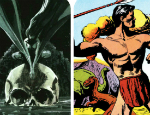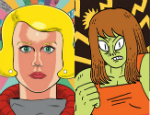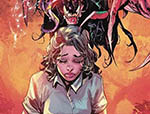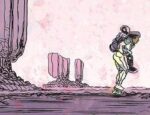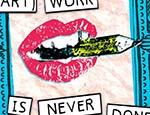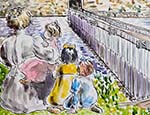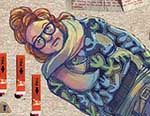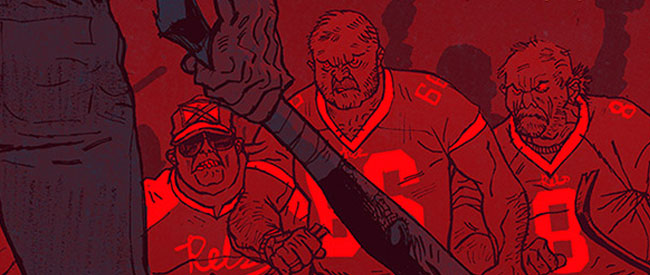
Review by Reid Vanier
The latest project by Jasons Aaron & Latour is a beautiful and compelling portrait of a reluctant homecoming; a contradiction of terms that is both a love letter and a manifesto to the South.
“I love being from the South. But I don’t live there anymore. And I don’t plan on ever moving back.”
That quote is pulled from Jason Aaron’s address to the reader in the back of Southern Bastards #1 – his latest collaboration with artist, and fellow Southerner, Jason Latour – but it could just as easily be the mantra of the book’s protagonist, Earl Tubb.
Unlike Aaron, Earl never left the South, living just outside Birmingham, but his reluctance to return to his hometown of Craw County, Alabama is just as potent. But return he must when his uncle is forced into a nursing home, leaving Earl to sort through and pack up the contents of his own childhood home. Earl’s return is full of encounters he would rather avoid, including a long overdue visit to his father’s grave and an unsolicited conversation when he is recognized at the bar by former acquaintance Dusty Tutwiler.

But there are other forces at work in Craw County. Earl’s brief homecoming forces him to confront the legacy of his late father, a former sheriff famous for surviving and beating a gang of attackers on his own property.
Snippets of newspaper headlines of the incident give the impression that this attack was part of something much larger; a feeling that is mirrored in the present day when Earl steps up to defend a surprisingly ungrateful Dusty from a representative of “Coach Boss”. Boss appears to be everywhere in town, his name emblazoned on various businesses, and Dusty owes him some stolen money. Intervening seems to have dragged Earl into the middle of this larger conflict, though he may not yet realize that.
The story elements are but brief introductions, as one would expect from a first issue, but Aaron’s writing succeeds at establishing both character and atmosphere. From accent to cadence to demeanour, each inhabitant of Craw County is markedly distinct from the rest, bringing the town (as well as its various threats) to life.
This strong characterization of both the people and the town will develop further through the series as Aaron lays down more and more actual history, but Jason Latour’s artwork has already hit the ground running. His muted colours and use of silhouettes emphasizes a sort of quiet desolation in the environment of Craw County. His attention to detail, including nearly imperceptible litter on the side of the road, is as nuanced as Aaron’s characterizations, giving the town itself a dynamic personality.
In fact, Latour’s art is really the driving force of this opener. His dynamic panel layouts are symphonic; the stillness and quiet of the town measured in large, single-panel beats while the escalating danger whips up a flurry of small, abrupt panelling. The red colouring of the flashback panels of Earl’s father not only helps to distinguish the events as a memory, but specifically as one Earl would like to forget.
There is a beautiful moment when Earl hears Dusty crying for help and the panel goes red, signalling not only Earl’s call to action, but also implying a deeper connection between the town’s present dangers and those faced by his father all those years ago.
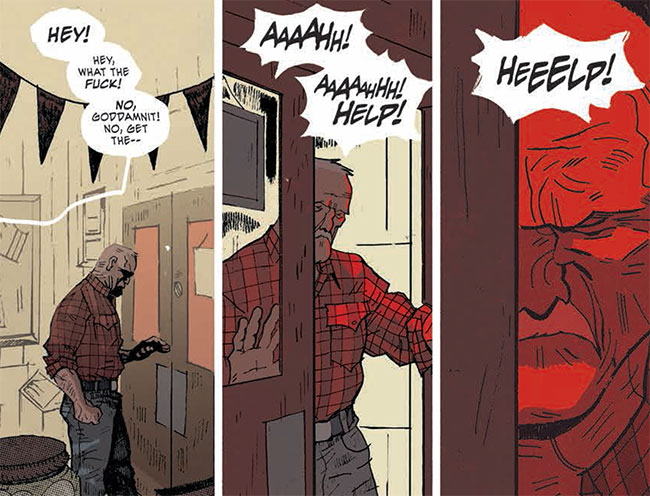
Southern Bastards paints a bold picture of the South that cannot easily be brushed aside. It blends the serene with the chaotic and blurs the good and the bad. Perhaps most importantly, the South depicted here already stands in as everyone’s hometown; full of people and places we’d rather forget, memories that haunt and ghosts that won’t stay down.
Aaron and Latour have created a “Southern-ness” that is more than accents and guns. It’s the simultaneous pride and shame in one’s past that, to some extent, everyone carries with them.





